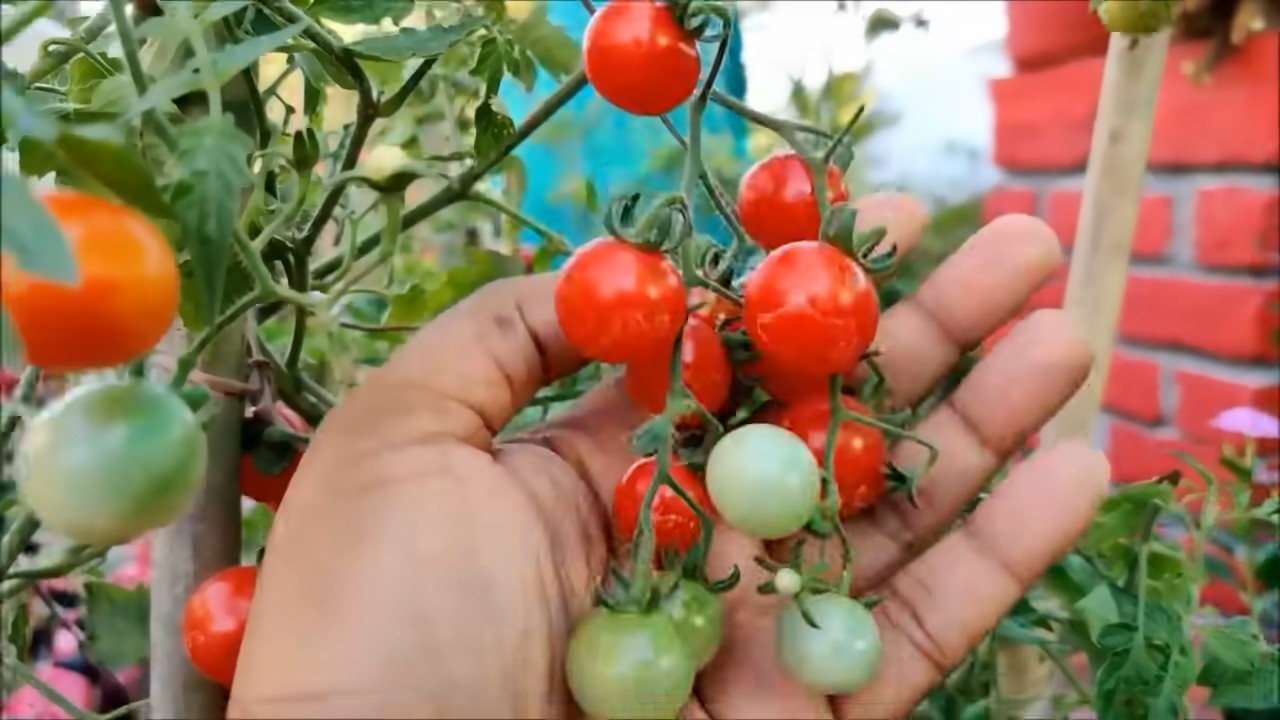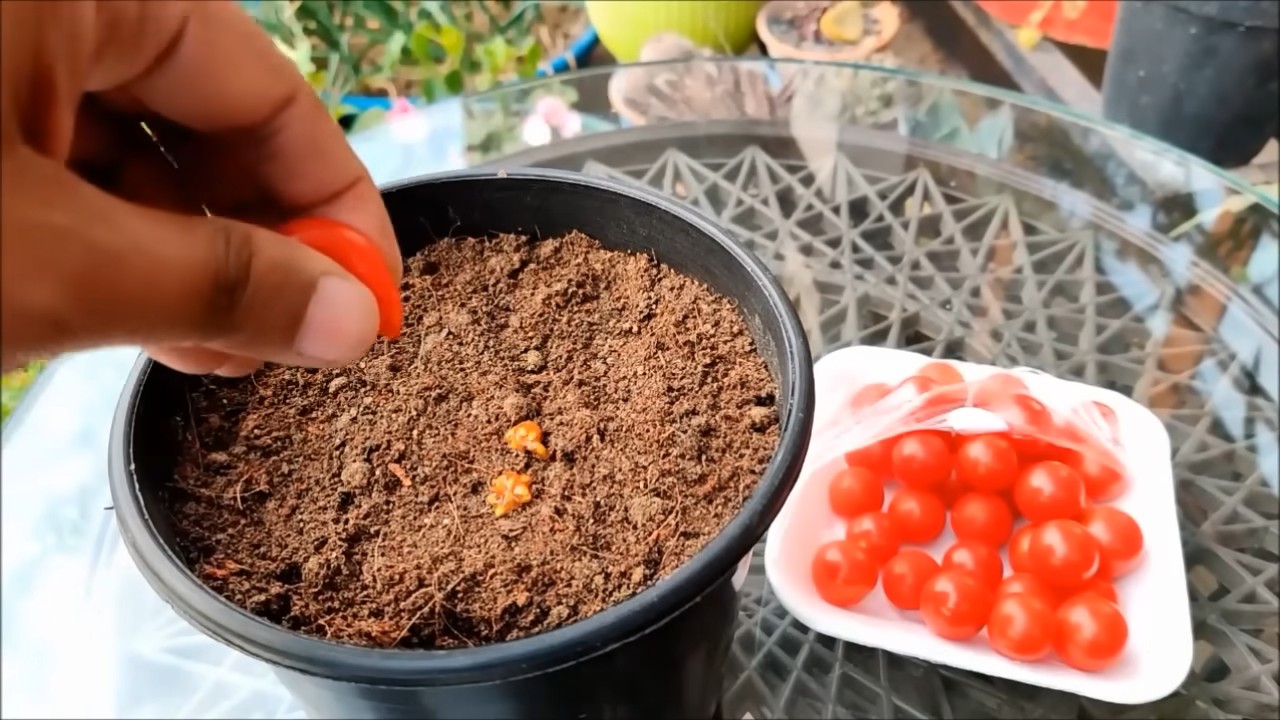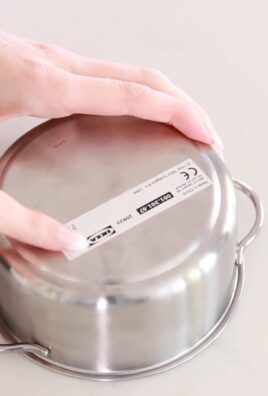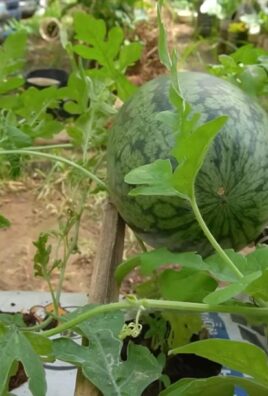Growing Cherry Tomatoes Home can be incredibly rewarding! Imagine popping juicy, sun-ripened cherry tomatoes straight from your garden into your salad or snacking on them fresh off the vine. There’s nothing quite like the taste of homegrown produce, and cherry tomatoes are a fantastic choice for beginner gardeners and seasoned pros alike.
For centuries, tomatoes, originating from South America, have been cultivated and enjoyed in various cultures. From the elaborate gardens of Renaissance Italy to the humble plots of modern-day urban dwellers, the allure of growing your own tomatoes has persisted. But let’s face it, sometimes getting those perfect little bursts of flavor can feel like a challenge. That’s where a few clever DIY tricks come in handy!
I’ve put together this guide packed with simple, yet effective, home gardening hacks that will help you maximize your cherry tomato yield and minimize common problems. Whether you’re dealing with limited space, pesky pests, or just want to boost your plant’s overall health, I’ve got you covered. Growing Cherry Tomatoes Home doesn’t have to be a daunting task. With these DIY solutions, you’ll be harvesting baskets full of delicious cherry tomatoes in no time. Let’s get started and transform your garden into a cherry tomato paradise!

Growing Delicious Cherry Tomatoes at Home: A DIY Guide
Okay, tomato lovers, let’s get our hands dirty! I’m going to walk you through everything you need to know to grow your own bountiful supply of sweet, juicy cherry tomatoes right in your backyard (or even on your balcony!). Trust me, there’s nothing quite like popping a sun-warmed, homegrown cherry tomato into your mouth. It’s a flavor explosion!
Choosing the Right Cherry Tomato Variety
First things first, let’s talk varieties. There are tons of different cherry tomato types out there, each with its own unique flavor, size, and growth habit. Here are a few of my personal favorites:
* Sungold: These are incredibly sweet and have a beautiful golden-orange color. They’re a bit more delicate than some other varieties, but the flavor is worth it!
* Sweet Million: As the name suggests, these produce a massive amount of small, red cherry tomatoes. They’re very prolific and relatively easy to grow.
* Black Cherry: These have a rich, complex flavor with a slightly smoky undertone. They’re a bit more unusual in appearance, with a deep reddish-purple color.
* Grape Tomatoes: While technically not *cherry* tomatoes, they’re very similar and often grouped together. They’re oblong in shape and have a slightly firmer texture.
Consider your space and preferences when choosing a variety. Some are better suited for containers, while others need more room to sprawl.
Getting Started: Seeds vs. Seedlings
You have two main options for starting your cherry tomato plants: from seed or from seedlings (also known as transplants).
* Starting from Seed: This gives you more control over the process and allows you to choose from a wider variety of tomato types. However, it requires more time and effort. You’ll need to start your seeds indoors about 6-8 weeks before the last expected frost in your area.
* Buying Seedlings: This is the easier and faster option. You can find seedlings at most garden centers in the spring. Just make sure to choose healthy-looking plants with sturdy stems and no signs of disease.
I personally prefer starting from seed because I love the whole process of nurturing a tiny seed into a thriving plant. But if you’re short on time or just want a head start, seedlings are a great choice.
Starting Cherry Tomato Seeds Indoors (If You Choose Seeds)
If you’re going the seed route, here’s what you’ll need:
* Cherry tomato seeds
* Seed starting trays or small pots
* Seed starting mix (a lightweight, sterile soil mix)
* A spray bottle
* A heat mat (optional, but helpful)
* A grow light (optional, but highly recommended)
Here’s the step-by-step process:
1. Sow the Seeds: Fill your seed starting trays or pots with seed starting mix. Moisten the mix with a spray bottle until it’s damp but not soggy. Sow 2-3 seeds per cell or pot, about 1/4 inch deep. Gently cover the seeds with more seed starting mix.
2. Water Gently: Use a spray bottle to water the seeds gently. Avoid overwatering, as this can lead to damping off (a fungal disease that can kill seedlings).
3. Provide Warmth: Place the seed starting trays or pots on a heat mat (if using) to provide bottom heat. This will help the seeds germinate faster.
4. Provide Light: Place the trays or pots under a grow light (if using) or in a sunny window. If using a grow light, keep it about 2-3 inches above the seedlings.
5. Keep Moist: Keep the seed starting mix consistently moist, but not soggy. Check the moisture level daily and water as needed.
6. Thin Seedlings: Once the seedlings have emerged and have a few sets of true leaves (the leaves that look like miniature tomato leaves), thin them to one seedling per cell or pot. Choose the strongest, healthiest-looking seedling and snip off the others at the soil line.
7. Harden Off Seedlings: Before transplanting your seedlings outdoors, you’ll need to “harden them off.” This means gradually exposing them to outdoor conditions over a period of 1-2 weeks. Start by placing them outdoors in a sheltered location for a few hours each day, gradually increasing the amount of time they spend outside. This will help them acclimate to the sun, wind, and temperature changes.
Transplanting Cherry Tomato Seedlings (or Store-Bought Seedlings)
Whether you started your own seedlings or bought them from a store, the transplanting process is the same. Here’s what you’ll need:
* Your cherry tomato seedlings
* A sunny location with well-drained soil
* Compost or other organic matter
* Tomato cages or stakes
* A trowel or shovel
* Water
Here’s the step-by-step process:
1. Prepare the Soil: Choose a sunny location that gets at least 6-8 hours of sunlight per day. Amend the soil with compost or other organic matter to improve drainage and fertility. Cherry tomatoes like slightly acidic soil, with a pH between 6.0 and 6.8.
2. Dig Holes: Dig holes that are slightly larger than the root balls of your seedlings. Space the holes about 2-3 feet apart, depending on the variety. Some bushier varieties may need more space.
3. Plant Deeply: This is a crucial step! Remove the seedlings from their pots and gently loosen the root balls. Plant the seedlings deeply, burying the stem up to the first set of leaves. Tomatoes can grow roots from their stems, so planting deeply will encourage a stronger root system.
4. Add Support: Install tomato cages or stakes at the time of planting. This will help support the plants as they grow and prevent the fruits from touching the ground.
5. Water Thoroughly: Water the seedlings thoroughly after planting.
6. Mulch (Optional): Apply a layer of mulch around the plants to help retain moisture, suppress weeds, and regulate soil temperature. Straw, wood chips, or shredded leaves are all good options.
Caring for Your Cherry Tomato Plants
Once your cherry tomato plants are in the ground, it’s important to provide them with proper care to ensure a bountiful harvest.
* Watering: Water your tomato plants deeply and regularly, especially during hot, dry weather. Aim to water at the base of the plants to avoid wetting the foliage, which can lead to disease.
* Fertilizing: Fertilize your tomato plants every 2-3 weeks with a balanced fertilizer or a tomato-specific fertilizer. Follow the instructions on the fertilizer label.
* Pruning: Pruning can help improve air circulation and encourage fruit production. Remove any suckers (the small shoots that grow between the main stem and the branches) that appear below the first flower cluster.
* Pest and Disease Control: Keep an eye out for pests and diseases. Common tomato pests include aphids, tomato hornworms, and whiteflies. Common tomato diseases include early blight, late blight, and blossom end rot. Treat any problems promptly with appropriate organic or chemical controls.
* Support: Make sure your tomato plants are adequately supported by their cages or stakes. As the plants grow and the fruits develop, they can become quite heavy.
Harvesting Your Cherry Tomatoes
The best part! Cherry tomatoes are usually ready to harvest about 60-80 days after transplanting. Look for fruits that are fully colored and slightly soft to the touch. Gently twist the tomatoes off the vine.
Harvest your cherry tomatoes regularly to encourage continued production. The more you pick, the more they’ll produce!
Troubleshooting Common Problems
Even with the best care, you might encounter some problems along the way. Here are a few common issues and how to address them:
* Blossom End Rot: This is caused by a calcium deficiency and results in a dark, leathery spot on the bottom of the tomato. To prevent blossom end rot, make sure your soil is well-drained and that you’re watering regularly. You can also add calcium to the soil by amending it with bone meal or crushed eggshells.
* Early Blight: This is a fungal disease that causes dark spots on the leaves. To prevent early blight, avoid overhead watering and provide good air circulation. You can also treat it with a fungicide.
* Tomato Hornworms: These are large, green caterpillars that can quickly defoliate your tomato plants. Handpick them off the plants and drop them into a bucket of soapy water.
* Cracking: This can happen when tomatoes experience rapid changes in moisture levels. Water regularly and consistently to prevent cracking.
Enjoying Your Homegrown Cherry Tomatoes
Now for the fun part! There are endless ways to enjoy your homegrown cherry tomatoes. Eat them fresh off the vine, add them to salads, roast them with herbs, or use them to make a delicious tomato sauce.

Conclusion
So, there you have it! Growing cherry tomatoes at home isn’t just a gardening project; it’s an investment in flavor, freshness, and a whole lot of fun. We’ve walked you through the essential steps, from selecting the perfect variety to troubleshooting common issues. But why is this DIY trick a must-try? Because nothing compares to the burst of sunshine you get from a sun-ripened cherry tomato, plucked straight from your own vine. The taste is simply unparalleled, far surpassing anything you’ll find in a grocery store. Plus, you have complete control over the growing process, ensuring your tomatoes are free from harmful pesticides and grown with love.
Beyond the basic method, there are countless ways to personalize your cherry tomato growing experience. Consider experimenting with different container sizes and materials. Terracotta pots offer excellent drainage, while self-watering containers can be a lifesaver for busy gardeners. You can also explore companion planting. Basil, for example, is known to improve the flavor of tomatoes and deter pests. Marigolds are another excellent choice for pest control.
For those with limited space, hanging baskets are a fantastic option for growing cherry tomatoes. Trailing varieties like ‘Tumbler’ or ‘Hundreds and Thousands’ are particularly well-suited for this method. Just be sure to provide adequate support for the vines as they grow.
Another variation to consider is growing different colored cherry tomatoes. From the classic red to yellow, orange, and even black varieties, the possibilities are endless. Imagine the vibrant salads you could create with your homegrown bounty!
Don’t be afraid to experiment with different fertilizers and watering schedules to find what works best for your specific growing conditions. Remember, gardening is a learning process, and every season brings new opportunities to improve your skills.
We wholeheartedly encourage you to give this DIY trick a try. Growing cherry tomatoes at home is a rewarding experience that will bring joy to your garden and your table. The satisfaction of nurturing a plant from seed to harvest is truly unmatched. And the taste of those sweet, juicy cherry tomatoes? Simply divine.
So, grab your seeds, prepare your soil, and get ready to embark on a delicious adventure. We’re confident that you’ll be amazed by the results. And most importantly, don’t forget to share your experience with us! We’d love to hear about your successes, your challenges, and any tips or tricks you’ve discovered along the way. Share your photos and stories on social media using [Your Hashtag Here] and let’s create a community of passionate cherry tomato growers! Happy gardening!
Frequently Asked Questions (FAQ)
What are the best varieties of cherry tomatoes to grow at home?
Choosing the right variety is crucial for success. Some popular and reliable choices include ‘Sungold’ (known for its exceptional sweetness), ‘Sweet Million’ (a prolific producer), ‘Black Cherry’ (a unique and flavorful heirloom), and ‘Gardener’s Delight’ (a classic and dependable variety). Consider your taste preferences and growing conditions when making your selection. If you have limited space, opt for bush varieties that don’t require staking.
How much sunlight do cherry tomatoes need?
Cherry tomatoes thrive in full sun, which means they need at least 6-8 hours of direct sunlight per day. Insufficient sunlight can lead to leggy growth, reduced fruit production, and bland-tasting tomatoes. Choose a location in your garden or on your balcony that receives ample sunlight throughout the day. If you’re growing indoors, consider using grow lights to supplement natural sunlight.
What type of soil is best for growing cherry tomatoes?
Cherry tomatoes prefer well-draining soil that is rich in organic matter. A good potting mix specifically formulated for vegetables is an excellent choice for container gardening. You can also amend your garden soil with compost, aged manure, or other organic materials to improve its fertility and drainage. Avoid heavy clay soils, as they can become waterlogged and suffocate the roots.
How often should I water my cherry tomato plants?
Watering frequency depends on several factors, including the weather, the type of soil, and the size of the container. As a general rule, water deeply and thoroughly when the top inch of soil feels dry to the touch. Avoid overwatering, as this can lead to root rot. During hot, dry weather, you may need to water daily. Mulching around the base of the plants can help retain moisture and reduce the need for frequent watering.
Do cherry tomatoes need fertilizer?
Yes, cherry tomatoes benefit from regular fertilization. Use a balanced fertilizer specifically formulated for tomatoes or vegetables. Follow the instructions on the fertilizer package carefully. Avoid over-fertilizing, as this can lead to excessive foliage growth and reduced fruit production. You can also supplement with organic fertilizers such as compost tea or fish emulsion.
How do I prevent pests and diseases from attacking my cherry tomato plants?
Prevention is key when it comes to pests and diseases. Start by choosing disease-resistant varieties. Practice good garden hygiene by removing any dead or diseased leaves. Water at the base of the plants to avoid wetting the foliage, which can promote fungal diseases. Monitor your plants regularly for signs of pests or diseases. If you spot any problems, take action promptly. Organic pest control methods, such as insecticidal soap or neem oil, can be effective for controlling many common pests.
When should I harvest my cherry tomatoes?
Cherry tomatoes are ready to harvest when they are fully colored and slightly soft to the touch. Gently twist the tomatoes from the vine. The flavor will be best when the tomatoes are fully ripe. Harvest regularly to encourage continued fruit production.
Can I grow cherry tomatoes indoors?
Yes, you can grow cherry tomatoes indoors, but it requires a bit more effort. You’ll need to provide adequate light, either through a sunny window or with grow lights. Choose a self-pollinating variety, as you may need to hand-pollinate the flowers indoors. Ensure good air circulation to prevent fungal diseases.
What are some common problems when growing cherry tomatoes and how can I fix them?
Some common problems include blossom end rot (caused by calcium deficiency), leaf curl (often caused by environmental stress), and pests like aphids and whiteflies. Blossom end rot can be prevented by adding calcium to the soil and ensuring consistent watering. Leaf curl can often be resolved by providing shade during the hottest part of the day. Pests can be controlled with organic pest control methods.
How can I encourage more fruit production from my cherry tomato plants?
To encourage more fruit production, ensure your plants are getting enough sunlight, water, and fertilizer. Prune suckers (the small shoots that grow between the main stem and the branches) to improve air circulation and direct energy towards fruit production. Hand-pollinate the flowers if necessary, especially if you’re growing indoors. Harvest regularly to encourage the plant to produce more fruit.





Leave a Comment